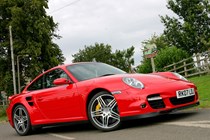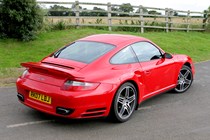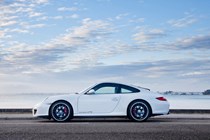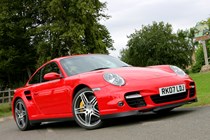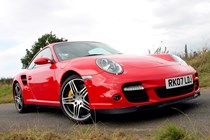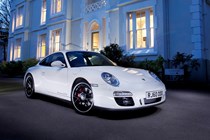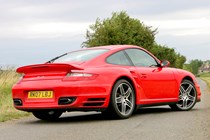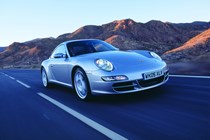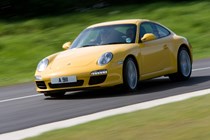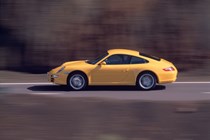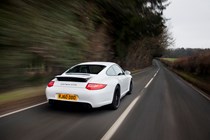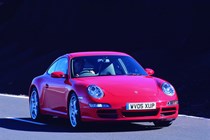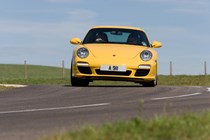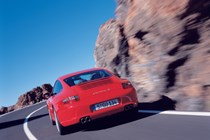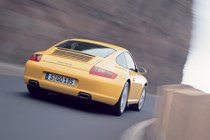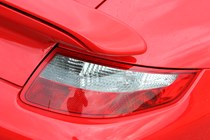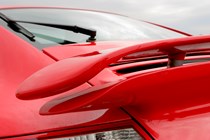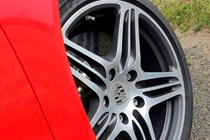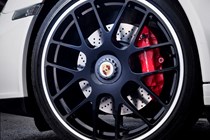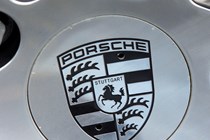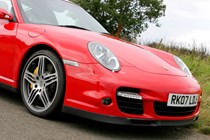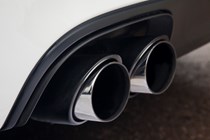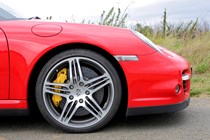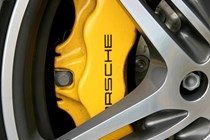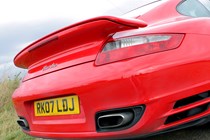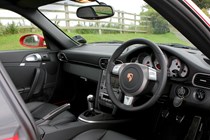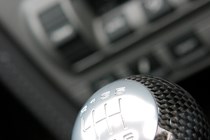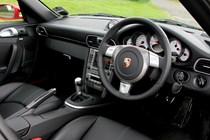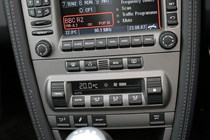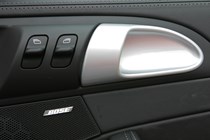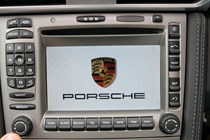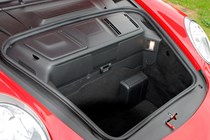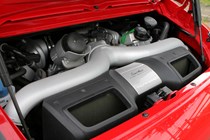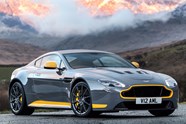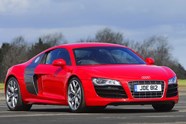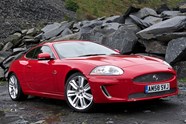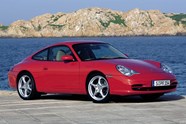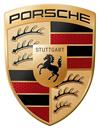
Porsche 911 Coupe (2004-2012) review

At a glance
| Price new | £61,675 - £171,523 |
|---|---|
| Used prices | £11,522 - £66,621 |
| Road tax cost | £430 - £760 |
| Insurance group | 49 - 50 |
Get an insurance quote with

|
|
| Fuel economy | Not tested to latest standards |
| Range | 295 - 436 miles |
| Number of doors | 2 |
| View full specs for a specific version | |
Available fuel types
Petrol
Pros & cons
- Outstanding performance and handling
- Classic styling with great build quality
- Typically reliable - up to a point
- Some of the things that can go wrong will cost you dearly
- Early models more issue prone
- But even later models can create big bills
Porsche 911 Coupe (04-12) rivals
Overview
The Porsche 911 built from 2004 until 2013, known as the Type 997, is perhaps the best value used 911 currently available. Not the cheapest – that honour still goes to the 996-generation 911 that preceded it – but as a refined version of that previous platform, boasting improved engines, more adaptable handling and much more classically handsome Porsche looks, the 997 is a great all-round buy.
It’s also generally considered to be a reasonably reliable Porsche. But that isn’t to say there aren’t problems to look out for – especially on the earlier cars – and you should still aim to buy very carefully. Which is where this page comes in.
Porsche 911 997 known faults and common problems
Below we’ve listed 10 of the most significant potential problem areas for the 997-generation of Porsche 911. This is not an exhaustive selection, and if you take one thing away from reading this let it be that we strongly recommend getting a profession pre-purchase inspection (known as a PPI) on any car of this type and cost before parting with your hard-earned money.
This may seem like an annoying extra expense, but there could be big bills ahead so it’s best to be as prepared as possible. For while it might be simplest to say buy a later facelifted car – known as the 997.2, these were sold from 2008 – as these typically have fewer problems than the pre-facelift (997.1) variants, they can still hide significant issues, and a good example of a 997.1 will be a much better purchase than a nasty 997.2 any day,
Buying guide
Common issues, and what to look for if you’re thinking of getting one
1. IMS Failure
Intermediate shaft bearing failure is better known as an issue for the preceding 996-generation of 911 but the 997 can suffer with this too. It’s almost certainly not as much of an problem as some alarmist forum and Facebook groups would make it appear, and it doesn’t affect Turbo or GT cars. But there are documented total engine failures caused by this (and the bore-scoring issue below) among the more common Carrera models.
Solutions are available and some advise proactive replacement. But it seems Porsche itself may have eliminated the problem for post-facelift models (known as the 997.2), as reports of the issue on these are basically non-existent – though other things can still go wrong and later engine failures aren’t unheard of. Look for cars with spotless service history to reduce your risk.
2. Bore scoring
Another issue the 997 carried over from the 996 that seems to have been rectified for later models is bore scoring. This is damage to the cylinder walls that can cause excessive oil consumption, and ultimately results in engine failure.
Symptoms include blackened tailpipes, especially on the left had side, poor running and tappety-style noises. A professional pre-purchase inspection may be able to look inside the cylinders for damage, but even this isn’t 100% reliable. Again, not as common as some areas of the internet would seem to suggest, but it is a risk you should be aware of. An engine rebuild on one of these is five figures, though many would argue it’s still worth it.
3. Cooling system and air-conditioning
Since we’re talking about ways the engine might die, be wary of the cooling system. Various components can fail – with age or accidental damage – including the radiators, crossover pipes, coolant reservoir and water pump. Proper service history should reduce the dangers, but be alert for the smell of hot coolant when driving.
Also make sure that the air-conditioning works. Sometimes this will fail because it needs regasing or one of the condensers is damaged – easy enough to resolve. But a leak in some of the pipework can be much more involved.
4. Electrics
Battery and alternator cables – particularly a part known as the Y cable – have long been an issue for early 997s. So much so that you’ll almost be unlucky to find one that’s problematic today as the cars involved will probably have been fixed already. But make sure any potential purchase starts strongly from hot as well as cold.
Coil packs have also been a historical problem for these 911s. Misfires and hesitation while driving may point to this.
Make sure everything inside the car works as it should – including the heating and ventilation controls as well as the electric windows and all of the door handles and locks. Try every switch, multiple times, just to be as certain as you can that there aren’t any intermittent issues.
5. Suspension
In a significant advance over the 996, the 997 was available with Porsche Active Suspension Management, an adaptive suspension system that allows you to vary the firmness of the ride and the responsiveness of the chassis. This can go wrong, and it isn’t cheap to fix. Check the different modes during the test drive, make sure it feels different (try the same bit of road multiple times if you can) and look out for warning lights.
As with all 911s, this one is very sensitive to suspension issues in general and works its components hard. Regardless of whether PASM is fitted, listen for knocks and rattles over bumps and surface changes. Some parts are easy and inexpensive to fix, but others will be more costly. Cheap replacement items wear out more quickly, so check available invoices carefully. A good geometry set-up by an experienced specialist is vital, too.
6. Brakes
The 997 was available with an upgrade to carbon-ceramic brakes, which perform brilliantly. However, they cost four times as much to replace, so consider carefully whether they are worth the expense. Even the standard steel items are going to be in the region of £1,000 for a full set of discs and pads.
Cars that haven’t been used much are likely to have corrosion on the back of the discs. This will be difficult to spot, but is the sort of thing that should be picked up by a professional inspection.
7. Gearboxes and all-wheel-drive systems
Manual gearbox cables wear out, and will probably need replacing at some point. Check the history to see if this has already happened, and make sure gears select nicely when driving.
Autos are conventional Tiptronic S on earlier cars, moving to the much more impressive first application of the PDK twin-clutch transmission on later models. Neither should be particularly troublesome, but make sure to give them a thorough work-out during the test drive and look for evidence of proper servicing on schedule.
As with the advance of PDK, so too is the all-wheel drive system on later cars more sophisticated than on initial examples.
8. Later direct injection engines
The fuel pump on the later ‘DFI’ – that’s direct fuel injection – engines is a rare failure, but an expensive one. Sadly, even the experts reckon there aren’t any symptoms to spot. As ever, this just reinforces the importance of knowing that there can be hefty costs involved in running one of these cars.
9. Wheels and tyres
Among the differences between the 996 and 997 is an increase in wheel size, with 19-inch alloys common as a result. It may seem a small thing, but this makes the wheels even easier to damage with kerbs or potholes. They are expensive to replace.
Similarly, tyres aren’t cheap due to their size and the need for high quality performance items. Look for matched sets and avoid cars fitted with budget brands – this paints a very clear picture about how well the car has been cared for.
10. Modifications and cosmetic issues
Staring with the cosmetic worries, the 997.2’s LED rear lights can fill up with condensation – which seems a paltry issue until you discover how expensive they are. Thinking is the earlier non-LED items don’t have the same problem because the bulbs run hotter and burn it off.
Examine the bodywork for excessive stone chips, daft dents and accident repair; rust should not be an issue on these yet, so if you see any, buy a different car.
We suggest you avoid modified examples of the 997 – this kind of thing varies in quality by an enormous amount, and is often to personal taste that others may not share. Making the car difficult to live with and hard to sell on, unless you’re prepared to spend the money reversing the changes.
What models and trims can you buy
The above and the next few pages – which consist largely of our original impressions of the 997 when it was new – mostly refer to the classic 911 coupe of this era. But it was also sold as a 997 convertible and a 997 Targa; if you’re thinking of one of these, extra precautions apply, especially in relation to their clever roofs.
There are no trim levels as such, since 911s vary with engine rather than basic specification – though this does also change with the engine, Porsche has a famously extensive options list that means almost no two 911s will be exactly alike. Availability varies over the model life of the car, but the line-up includes Carrera, Carrera 4 (with all-wheel drive), GTS, Turbo and Turbo S, plus the exceptionally driver-focused GT3, GT3 RS, GT2 and GT2 RS.
Many consider the GTS the sweet spot for an everyday, highly engaging sports coupe, while other important milestones include the introduction of the PDK dual-clutch automatic transmission on the 997.2.
Over the next few pages, we’ll review each aspect of the Porsche 911 997, taking into account its practicality, comfort, fuel economy and performance. If you’re short on time, you can also skip to our verdict page to see if we recommend this 911 as a good used car.
As with all used purchases, do remember to get a car history check. It might just save you from an unpleasant surprise later down the line. Also, don’t forget you can use our valuation tool to get an idea of how much you should be paying for a car. You can also check our reviews section for more information about the cars you are interested in.


